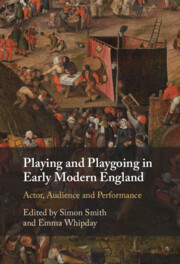Book contents
- Playing and Playgoing in Early Modern England
- Playing and Playgoing in Early Modern England
- Copyright page
- Contents
- Illustrations
- Notes on Contributors
- Acknowledgements
- A Note on the Text
- Introduction
- Part I Players
- Part II Playgoers
- Part III Playhouses
- Chapter 9 ‘Theatre’ and ‘Play+House’: Naming Spaces in the Time of Shakespeare
- Chapter 10 ‘[T]hough Ram Alley Stinks with Cooks and Ale / Yet Say There’s Many a Worthy Lawyer’s Chamber / Butts upon Ram Alley’: An Innsman Goes to the Playhouse
- Chapter 11 Playing with the Audience in Othello
- Chapter 12 ‘All Their Minds Transfigured So Together’: The Imagination at the Elizabethan Playhouse
- Bibliography
- Index
Chapter 11 - Playing with the Audience in Othello
from Part III - Playhouses
Published online by Cambridge University Press: 10 March 2022
- Playing and Playgoing in Early Modern England
- Playing and Playgoing in Early Modern England
- Copyright page
- Contents
- Illustrations
- Notes on Contributors
- Acknowledgements
- A Note on the Text
- Introduction
- Part I Players
- Part II Playgoers
- Part III Playhouses
- Chapter 9 ‘Theatre’ and ‘Play+House’: Naming Spaces in the Time of Shakespeare
- Chapter 10 ‘[T]hough Ram Alley Stinks with Cooks and Ale / Yet Say There’s Many a Worthy Lawyer’s Chamber / Butts upon Ram Alley’: An Innsman Goes to the Playhouse
- Chapter 11 Playing with the Audience in Othello
- Chapter 12 ‘All Their Minds Transfigured So Together’: The Imagination at the Elizabethan Playhouse
- Bibliography
- Index
Summary
Othello has long been a play that has provoked audience interjections. This chapter gives an account of a production staged by The Pantaloons theatre company in 2019 that was put together in order to explore the effects of direct audience address, playfulness and spontaneity. Player/playgoer relationships can be anticipated in the text, but they cannot be pre-programmed: they are determined by the moment-by-moment unfolding of the drama as it is played between actors and audience under specific, never-to-be-repeated conditions. Practice-as-research of this kind allows for a close-up examination of particular instances of actor/audience contact, and emphasises the creative role of the actor (and indeed the audience) in bringing ‘the play’ into its always-transient existence. Making detailed reference to the production’s rehearsal process, its development over the tour, the perspectives of its cast, and the responses of its audiences, this chapter argues that seeking opportunities for direct audience contact in Othello allows for a range of affective and ethical relationships between player and audience, some of which can have a substantial impact on the ways in which the play makes its meanings. It concludes with some thoughts about the possibilities inherent in conceptualising performance as play rather than as ‘acting’.
- Type
- Chapter
- Information
- Playing and Playgoing in Early Modern EnglandActor, Audience and Performance, pp. 223 - 241Publisher: Cambridge University PressPrint publication year: 2022

